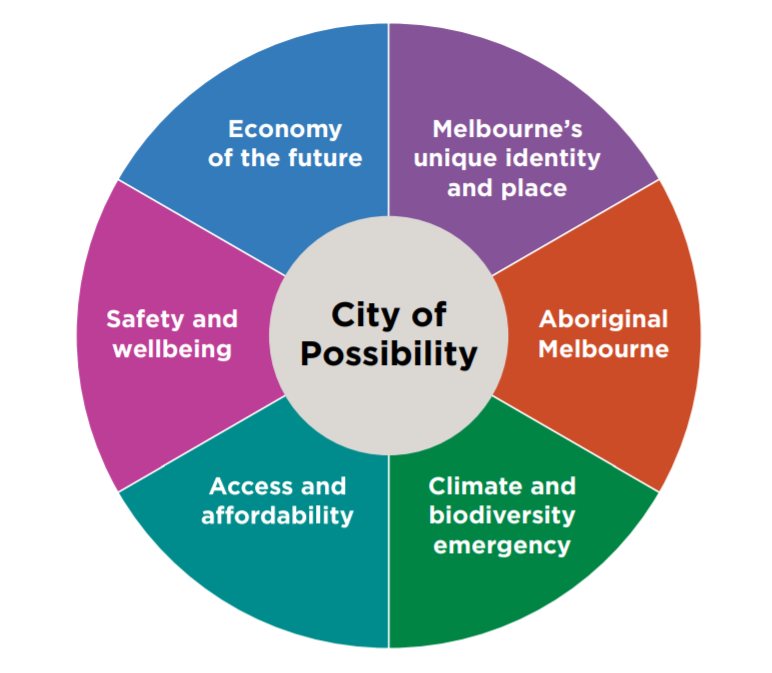Community connection
- Read fill-in-the-blanks postcards.
- Host a (virtual) tea party.
- Explore the community wall.
If viewing on mobile, hold and swipe tabs left to view all.
Have a browse of what other people in our neighbourhood have already pinned on the map, and see what they said the Melbourne CBD’s neighbourhood assets and strengths are.
We asked:
We also asked to know about areas of the CBD where there’s an opportunity or improvement for Council and/or the community to address.
The central city, sometimes referred to as the CBD, or the Hoddle Grid, is the heart of Melbourne and the economic and cultural capital of Victoria. Laid out in 1837, it encompasses the area from the Yarra River Birrarung to Victoria Street, and Spencer Street to Spring Street.
The central city is the centre of the highest density of jobs and activity in Victoria, where over 900,000* people come to live, work and visit every day.
It is home to Melbourne’s famed laneways, arcades and café culture, a distinct blend of contemporary and Victorian architecture and a diversity of events, shopping, dining, and nightlife. It is a truly mixed use area with a number of different character areas within it, including the Little Bourke Street Chinatown precinct.
Many of Melbourne’s most iconic landmarks are located here, including the State Library of Victoria and Federation Square, Melbourne’s major public square and cultural events space, situated opposite Flinders Street Station, the centre of Melbourne’s public transport network.
*based on pre-covid data
Boundary of Melbourne Central City - select image to enlarge
Data is sourced from 2016 Australian Bureau of Statistics (ABS) Census of Population and Housing, SGS Population Forecasts, and 2020 Census of Land and Employment (CLUE). To learn more about the ABS Census of Population and Housing, including definitions, visit: Guide to Census data.
At the City Library we provide loans of books and other material to approximately 7,100 members. We run programs for children, teenagers and adults and have a social worker based at the library.
The City of Melbourne also manages the Melbourne Town Hall, Multicultural Hub and Drill Hall which have bookable spaces for community use.
In the CBD - Hoddle Grid we manage and maintain many public spaces including Batman Park, Cohen Place Plaza, Customs Square, Eight Hour Reserve, Enterprize Park, La Trobe and Exhibition Street Reserve, Merritts Place Reserve, Northbank and Royal Society.
We support the creative sector through venues we manage and operate. In 2021-22 we will support three exhibitions at City Gallery, 22 exhibitions at Dirty Dozen and Capsule and support an artist in residence at Shop 5 Little Collins Street. ArtPlay and SIGNAL provides creative opportunities for children and youth. We will also deliver six Town Hall Grand Organ concerts and three Federation Bells performances every day.
We continue to operate our visitor information centres in Bourke Street, Town Hall and at Queen Victoria Market.
The Melbourne City Baths has approximately 1300 members and 200,000 visits annually. The venue offers a gym, group fitness, swimming pool, swimming lessons, squash, facility hire and Mikvah Bathhouse. The YMCA operates the facility on behalf of the City of Melbourne.
See the ideas forum.
Seven initiatives represent our city’s plan for reactivation and recovery following the COVID-19 pandemic. Together, they connect our immediate response to the crisis with our city’s longer-term regeneration. By linking the actions that we take in the short-term with the outcomes we want to see in the future, we can ensure that we target our resources to those initiatives that best meet our long term strategic objectives and ultimately deliver maximum benefit for our city and its citizens.
Read the full consultation recap.
The COVID-19 Reactivation and Recovery Plan integrates with the Council planning framework and City of Melbourne’s strategic plans and is designed to help guide and shape our work now and into the future.
Read the COVID-19 Reactivation and Recovery Plan.
We spoke with more than 750 people who live, work, study, visit or own a business in the municipality to understand what our community values most about the city.
Overall, the community’s top aspirations were for Melbourne to be a city that:
Read the full consultation recap.
The community’s feedback was gathered and synthesised into a series of insights and aspirations that helped to create the 10-year Community Vision and four-year Council Plan.
Read the Consultation Report (PDF 1.06MB).
Six strategic directions from the Council Plan include:

New investments and upgrades in the CBD this year include:
We will invest $6,593,800 on renewal works in the CBD including for roadways, footpaths, drains, kerb and channel, parks, landscape, banner poles, library collection and property.
We will invest $3,093,692 on maintenance works in the CBD including at our community facilities and other property, for urban forest health, pedestrian infrastructure, wayfinding signage and smoke free areas initiatives.
This year we will:
We will progress delivery of: